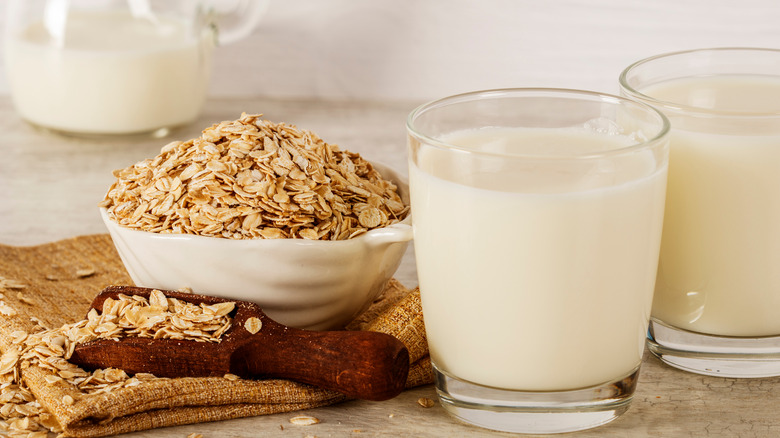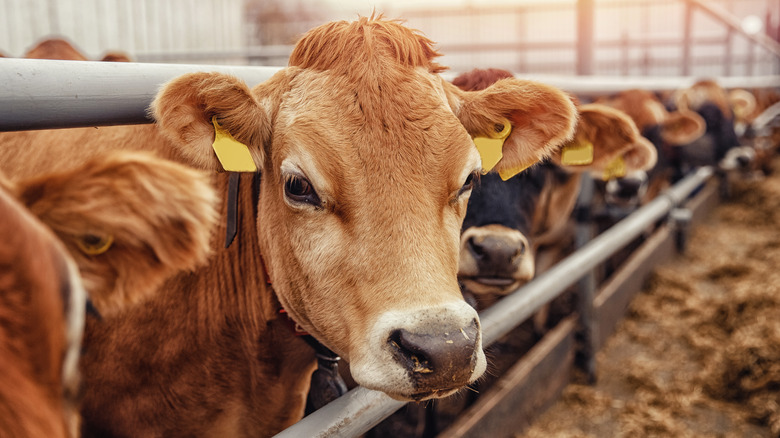Here's Why Oat Milk Is So Expensive
On the surface, it would seem that oat milk should be cheaper than dairy milk. Oats seem cheaper to farm than dairy cows. Resource-wise, it takes 8% of the land and 7.6% of the water to grow oats compared to farming cows. Farming and milking dairy cows must be more resource-intensive than harvesting and soaking oats. You can make oat milk at home for pennies per serving. So why is oat milk from the store so expensive?
There are many factors at play here, adding up costs that get passed to the consumer at the grocery store: Labor, oat crop shortages, cost of fuel and fertilizer, as well as additives for taste, mouthfeel, and stability.
As far as commercial oat milk goes, there's a reason it generally tastes better than the soaked, blended, and strained version you make at home. There's more that goes into it than your countertop blender, oats, water, salt, and a nut bag. Oats are difficult to emulsify because of their high starch content. Commercial oat milk uses enzymes to break these starches down, helping not only the emulsification process but taste, amplifying natural sweetness. It has traces of vegetable oils and additives that are specially emulsified into the liquid like locust bean gum, acacia gum, and carrageenan; the process of emulsifying these into a smooth and creamy liquid is almost impossible with the equipment available to home cooks (unless you have a homogenizer sitting in your cabinet). And that's not the only factor affecting cost.
Other costs
As with everything, there are costs to production and distribution associated with store-bought oat milk, and all of those costs go into the price of a product. According to the CEO of oat milk company Califia Farms, Dave Ritterbush, it's a rise in everything: Wages, the costs of running the factory, transport to the grocery store, utilities, fuels, packaging, marketing, R&D.
The cost of labor — employee wages — has gone up in many industries and across many states that have legislated higher minimum wage rates. Wages haven't jumped up more than an average of 5% year-over-year, though, and 5% of a $6 half-gallon is $0.30. Wages still haven't caught up with inflation, of course, which is why oat milk still feels expensive at checkout, even if you're making more money than you were years ago. Speaking of inflation, it has been a factor in prices — perhaps you remember how much eggs cost in 2022 — but it's dropped substantially in 2023. Ritterbush told The Guardian that the price of plant milk won't come back to pre-inflation costs, but "it will come off those highs."
So what else is driving up the price of oat milk? The increased cost of energy and fuel has been driven by Russia's war in Ukraine. Bad growing seasons in the American Plains states, likely as a result of climate change, have led to a lack of oat crop supply. These two factors are huge drivers of soaring oat milk prices.
Dairy milk is subsidized, plant milks aren't
Part of the sticker shock with oat milk stems from the comparison to dairy milk prices, which are generally 2.5 times lower than oat milk. Dairy milk also has production costs, plus all the additional resources it takes to raise cows. So why is dairy milk drastically cheaper than plant milks? The answer is that plant-based milks don't benefit from the same government subsidies as dairy milks. This means 100% of the cost of production is passed on to the customer, rather than the 55% left over after dairy subsidies.
Dairy has been subsidized in the U.S. since the 1930s, which has led to massive overproduction of milk. When there's too much of something with a short shelf-life, that leads to low prices (and low margins — dairy farmers generally only see a 3% net profit on milk, according to data analytics firm Mintec, compared to 15% net profits on plant milk). The subsidies guarantee a certain payout per 100 gallons of milk, which allows for lower retail prices. Without subsidies, some estimates show that milk would be almost double its retail cost.
As is true with any new industry, plant-based milks don't benefit from the same economies of scale as dairy milk, and spending on marketing is greater than that of dairy milk (which, too, has historically been subsidized). These costs will decrease with time for oat milk, but without subsidies, plant-based milks will likely never be as affordable as dairy milk.


